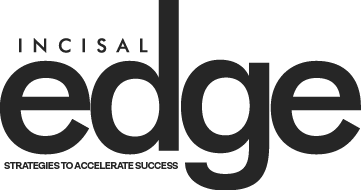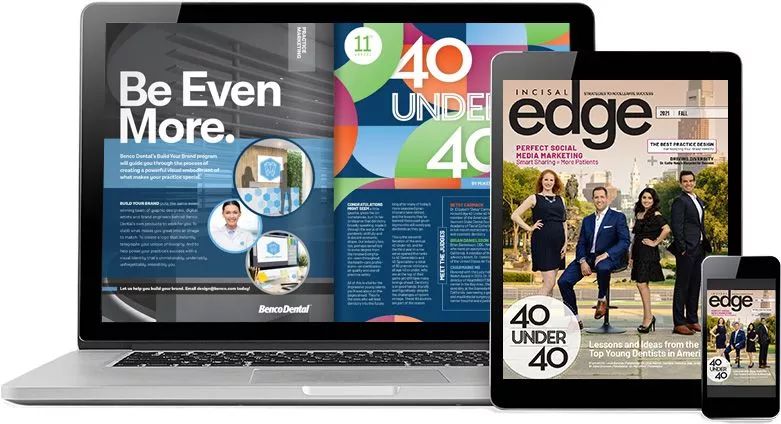America’s largest dental school drives many of today’s educational trends. NYUCD’s dean, Charles Bertolami, previews what’s next.
BY ALEXANDRA LEVINE
FOR THE PAST five years, Incisal Edge has featured our annual
“40 Under 40” list of America’s top young dentists. Over that time, New York University’s College of Dentistry has had more of its graduates featured than any other school in the country.
NYUCD, the U.S.’s largest dental school, is also one of the most competitive and diverse. This year alone, it accepted just 8 percent of 5,000 applicants, drawing top talent from Canada, South Korea, China and Venezuela as well as the U.S. The school’s dean, Dr. Charles Bertolami (left), sat down with us to discuss his personal journey to NYUCD — and where it’s heading on his watch.
Incisal Edge: Which initiatives at NYUCD set the school apart?
Dr. Bertolami: Our basic approach for differentiating NYUCD from other dental schools is a distinctive educational philosophy I call an “aspirational curriculum.” It has three parts: first, clinical excellence. Dentistry and dental hygiene are technical disciplines that demand fine motor skills and an aptitude for three-dimensional visualization. Using laboratory and simulation exercises, most students become quite adept from the technical perspective, with all passing the licensing examinations for the jurisdictions in which they choose to practice or teach.
Second, cultivating an identity as a man or woman of science. We define a man or woman of science as a sophisticated consumer of research — someone who knows that a scientific literature exists, knows where to find it, can read it and find it intelligible, critique it and then transfer the knowledge gained to practical application in the clinical care of patients.
Third, what I call “something more.” This refers to that empathic element we all want in our own health-care providers. Absent this, clinical skills and scientific acumen alone combine to yield Mr. Spock. Our aim is to produce practitioners who are socially poised, outgoing and cheerful, and not prone to fearfulness or worried rumination. [Dentists] with a capacity for commitment to people and causes, for taking responsibility, for having an ethical outlook, for being sympathetic and caring, comfortable with themselves, with others and with the social universe in which they live.
Incisal Edge: What about technology?
Dr. Bertolami: Technological innovation is another differentiating factor in our curriculum. NYUCD was among the first dental schools to employ lecture-capture techniques such as iTunesU and, now, Mediasite; we routinely use Webinars and, increasingly, blended online and in-class learning. A recent major technological enhancement to our educational program is an electronic health record, or EHR. The system integrates the patient health record, billing and student progress in ways that go far beyond office- or hospital-based electronic records. NYUCD also remains the only dental school in the U.S. to rely exclusively on the use of plastinated human specimens in the teaching of human anatomy.
“We define a man or woman of science as a sophisticated consumer of research: someone who knows that a scientific literature exists, can critique it and then transfer the knowledge to practical application in the clinical care of patients.”
Incisal Edge: What has NYUCD done to get its graduates ready to go into solo private practice right out of school?
Dr. Bertolami: NYUCD graduates are prepared to go into practice immediately because NYUCD receives 280,000 patient visits a year, making our patient population the largest and most diverse in the nation and ensuring extraordinary clinical experiences. Also, a focus on evidence-based practice teaches students to rely on solid data to treat people throughout the lifespan.
Incisal Edge: What is the one piece of technology or research at NYUCD that you’re most excited about right now?
Dr. Bertolami: We have built an extraordinary research faculty and have significant NIH- and corporate-funded studies underway. These include gene-therapy research that may hold the key to eliminating oral-cancer pain, osteocytes’ potential to improve clinical management of osteoporosis, the role of parathyroid hormone action in bone and mineralized tissue, the potential of a diabetes drug to prevent prostate cancer, the role of salivary diagnostics in detecting oral and systemic diseases, and development of a test to detect HIV antibodies and HIV RNA in a single POC diagnostic device.
One particularly exciting area right now concerns potential productive synergies between NYUCD’s Department of Biomaterials and the NYU Bioengineering Institute, which are both housed in the 13-floor, 170,000-square-foot new building that NYU opened in January 2015, and which is adjacent to our main campus.
Incisal Edge: What’s the biggest challenge that NYU dental students face after graduation? What was the biggest you faced?
Dr. Bertolami: The thing that most students worry about is educational debt. The problem with student debt is not that the graduate will not realize a wonderful and productive career, but rather that the option for graduates to practice in underserved areas or to enter academic careers may be more constrained. Tuition-forgiveness programs for graduates practicing in designated underserved areas or entering academics would be a big help.
I think things are actually better now. When I graduated from dental school, there was a sense that dental caries was going to be cured and that the need for dentists would diminish. It wouldn’t be long before dental schools would begin to close, class sizes decrease, applicant numbers decline and curricula lengthen. It wasn’t clear that the dental profession would prosper. There had even been some talk about eliminating pediatric dentistry as a specialty. None of this was true — in fact, things turned out to be quite the opposite.
Incisal Edge: What was your professional path, from the get-go until you became dean of NYUCD?
Dr. Bertolami: I probably became interested in the field much earlier than most people, at about age 11 — mainly because I was attracted to technical things and using my hands. Dentistry blended the technical, artistic and scientific, while offering the opportunity to do something valuable that people appreciate. I started out at Lorain County Community College [in Ohio] and ended up at Harvard.
When I was in dental school at Ohio State University, I was initially drawn to oral and maxillofacial surgery but developed an interest in research during a National Institute of Dental Research summer program at the University of Colorado in Boulder. Seeking a dual program, I ultimately attended the Massachusetts General Hospital–Harvard oral-surgery program because it enabled me to combine research and surgery.
I became a dean not out of any desire for leadership per se, but because it encompasses research, teaching and clinical care, but at a different level of implementation. The real work is done by faculty and students, but deans can influence these critical activities by managing resources — human, physical and financial. I was dean of the University of California San Francisco School of Dentistry from 1995 to 2007, and I have been dean at NYUCD since 2007.



